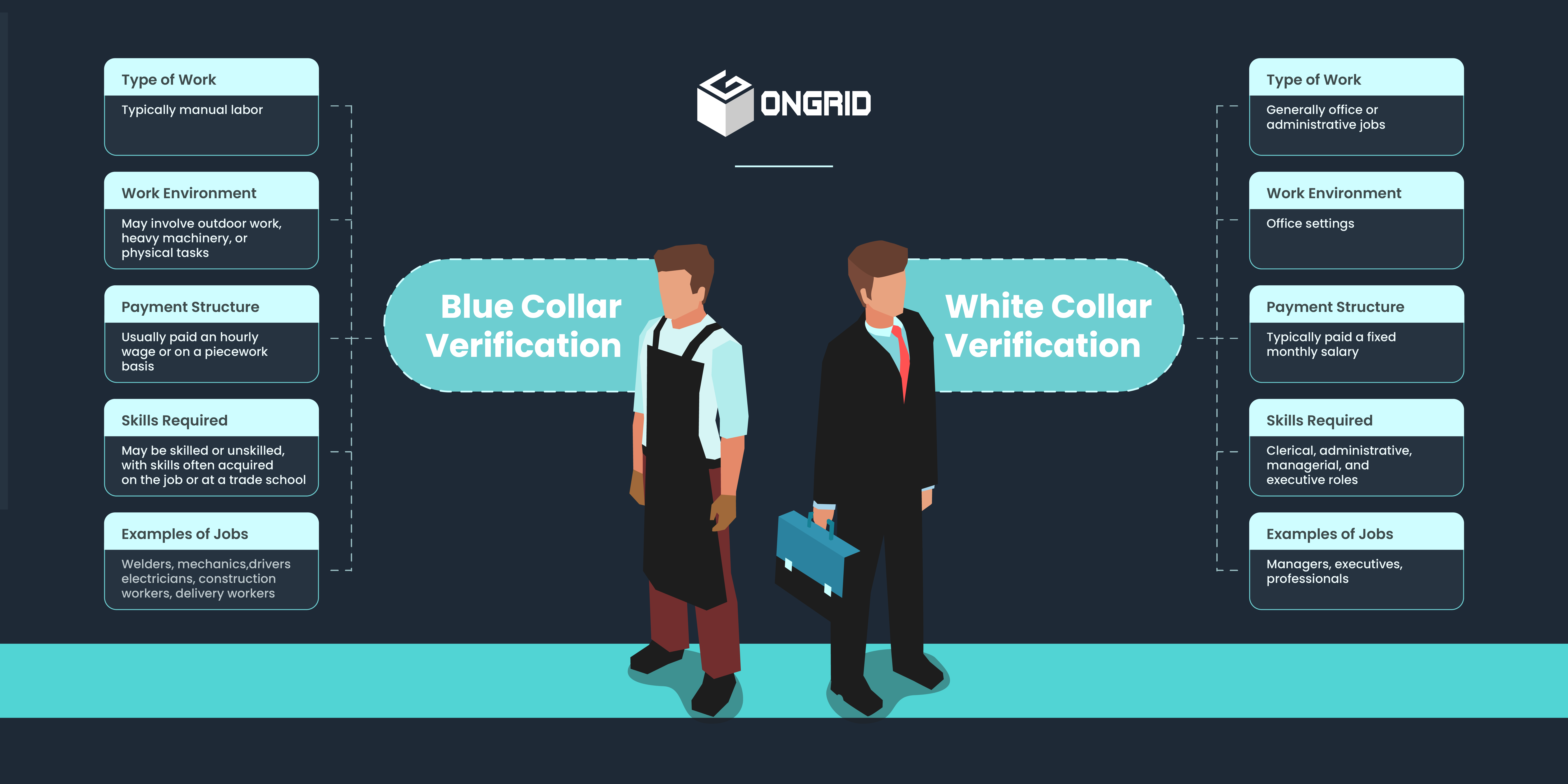Table of Contents
ToggleIn today’s dynamic workforce, the classification of employees into blue collar and white collar categories holds considerable importance, especially in the realm of background verification (BGV). Blue collar workers typically engage in manual or labour intensive tasks, while white collar employees are associated with professional or administrative roles.
Distinguishing between these categories is crucial in the BGV process due to the unique nature of their roles and associated risks. For instance, while verifying qualifications and employment history may be paramount for white collar positions, assessing skills and certifications could be more pertinent for blue collar roles.
In this blog post, we dive into the complexities of background verification (BGV) for blue collar and white collar employees, alongside recent hiring trends in India. We’ll also examine the essential checks recommended for these categories, empowering organizations to make well-informed hiring choices and uphold workforce integrity.
Who are White Collar Employees?
White collar employees are typically associated with salaried professional roles that require a certain level of education and expertise. These roles often involve managerial or administrative work in office settings. Examples include executives, IT professionals, accountants, and consultants. These employees often have a higher level of education, including bachelor’s degrees, master’s degrees, or even doctorates.
Who are Blue Collar Employees?
Blue collar employees are typically involved in manual labor or skilled trades. These jobs may include roles in manufacturing, construction, maintenance, and transportation. While formal education levels may vary, the focus for these roles is often more on skills, hands-on experience, and vocational training. Examples include electricians, plumbers, factory workers, taxi drivers, delivery agents and truck drivers.
Blue Collar Vs White Collar

In recent years, India’s hiring landscape has undergone a noticeable transformation. While the demand for white collar jobs continues to climb, there has been a marked increase in the recruitment of blue-collar positions.
According to data from Indeed, a leading global hiring and matching platform, the blue collar workforce in India saw a 7.40% surge in hiring during 2023. This notable shift underscores the importance of implementing robust and efficient background verification (BGV) processes for both white collar and blue collar employees.
Recommended BGV Checks for White Collar Employees
For white collar employees, the BGV process is often more extensive due to the nature of their roles. It typically includes:
Education Verification: This involves confirming the authenticity of educational qualifications from the institutions listed by the candidate.
Employment History: This includes verifying previous employment details such as job titles, responsibilities, and duration of employment.
Reference Checks: References provided by the candidate are contacted to gather more information about the candidate’s work ethic, skills, and behavior.
Criminal Background Check: This ensures the candidate has no criminal history that could pose a risk to the organization.
Global Database Check: This includes scrutinizing international databases to verify if an individual has been involved in fraudulent, terrorist, or criminal activities, appears on sanctions or blacklists, or has faced legal or regulatory enforcement.
Credit Check: This process involves assessing an individual’s credit history, including their credit score, loan payments, and credit card activity, obtained from a reputable third party credit bureau. It aims to determine the candidate’s financial reliability and creditworthiness.
Drug Test: Given the nature of their roles, white collar employees may also be required to undergo drug tests to ensure they are fit for the job and maintain a safe and healthy work environment.
For more details: White Collar Verification
Recommended BGV Checks for Blue Collar Employees
For blue collar employees, the BGV process may be slightly different, focusing more on the following aspects:
Identity Verification: This involves confirming the candidate’s identity through government issued documents like Aadhaar, PAN, or Passport.
Address Verification: This includes verifying the candidate’s residential address to ensure reliability.
Criminal Background Check: Similar to white collar employees, this ensures the candidate has no criminal history.
Police Verification: This involves verifying an individual’s background for any criminal records within the jurisdiction of local police stations. This process is conducted to gather information and ensure that no criminal offenses have been registered against the candidate.
For More Details: Blue Collar Verification
How OnGrid Can Help?
OnGrid offers tailored verification solutions for blue collar and white collar employees, addressing their distinct needs. We verify critical credentials such as identity and court records for blue collar workers, ensuring compliance and reliability.
For white collar employees, we cover educational qualifications and past employment records, providing a comprehensive perspective. With OnGrid, organizations can streamline verification processes and make informed hiring decisions effectively.
Conclusion
Understanding the differences between blue collar and white collar BGV is crucial in today’s diverse workforce. With the right tools and processes, companies can ensure they hire reliable and qualified employees.
OnGrid’s comprehensive solutions provide companies with the means to navigate these processes with ease, ensuring they hire the right people for the right roles, thereby fostering a safe and productive work environment.





Leave a Reply